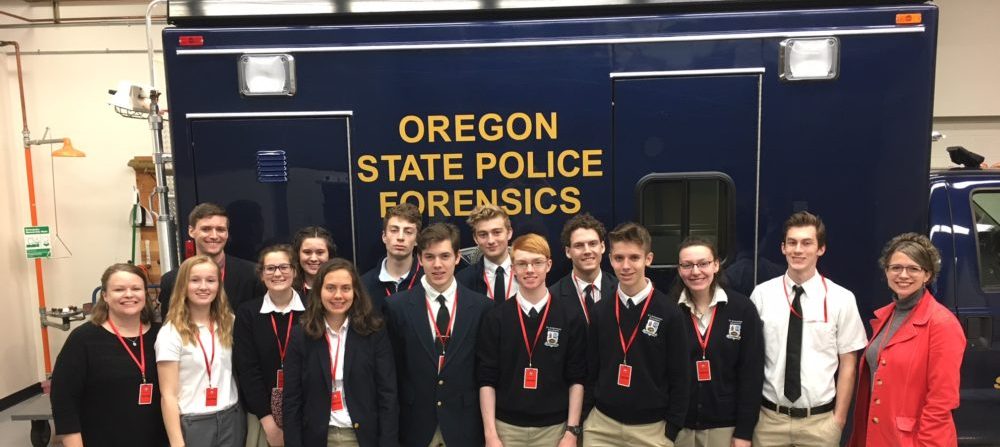26 Apr Oregon State Police Forensic Lab Field Trip
by Katherine D., 11th grade

There are a few professions that you see in movies that you rarely get a chance to see in real life. One of these professions is that of forensic scientists. They’ll show up in police shows every once in a while. The main characters will send in a piece of evidence found on the scene, and a quick scene cut later the scientist has found the person who left the incriminating evidence. And so the plot moves on.
This always seemed a little “hand-wavy” to me. What do the forensic scientists actually do? How do they do it?
Well, last Wednesday, the St. Stephen’s Academy Juniors learned what really happens under the hood of a forensic lab. We visited the Oregon State Police Forensic Laboratory, and, I have to tell you, there is no hand waving involved.
We arrived, yawning, at the lab around 8:00 in the morning. We were signed in, given our visitor lanyards, and invited into the building. I soon found any trace of tiredness erased.
The tour started with a look through the windows of the Biology Lab. We were not allowed to enter, I assume because of the lab-coated scientist who was at that very moment processing evidence.
Our next stop was Evidence Lock-up. As we were walking up, the evidence custodian was taking in evidence. She showed us how she would take in and log evidence, how every step was double checked, and how every piece of evidence was carefully kept track of. She then told us stories of interesting evidence she had taken custody of over the years. One of which involved a homemade spear and another a FedEx worker most likely being fired.
After that was a visit to Crime Scenes, where we learned the methods used by forensic scientists to locate the source of a blood splatter or a bullet. (Imagine how we felt when we realized the math they were using was the same sort of calculations we’d learned in precalculus days earlier!)
Then we had a tour of the Firearms Lab (which, according to one of the scientists, is the best department, a sentiment contested by his wife). We learned how they could identify the make and model of a gun by the grooves left in a bullet it had shot. We also saw interesting weapons, such as a gold-plated Desert Eagle, a World War I machine gun, and a handgun that looked like it was misplaced from a science fiction movie set.
Then we took a trip outside to see for ourselves the differences between black powder and gunpowder. I won’t tell you exactly what happened. My advice: if you find yourself near an open flame and black powder, take a step back, maybe a few steps back.
In Chemical Analysis, we learned that forensic scientists love puns and can identify a drug’s source from the minutest change in its chemical structure. We also learned about the procedure they go through in their machines to keep the results as accurate as possible.
In Toxicology, we learned how difficult it is to identify a contaminant that has already been processed by a human body. We also saw a machine the size of a fridge that cost as much as a house.
In Trace Evidence (which, according to one of the scientists, is the best department, a sentiment contested by her husband) we learned how the smallest detail can be used to identify a car in a hit and run, or how to identify a suspect’s shoes from a footprint left at a scene.
In Latent Prints, we learned that finding and identifying a print was not the easy, clean, process that movies lead us to expect. We got a chance to use three separate methods to find prints on pieces of evidence, we also got to wear lab coats and tinted glass while we were doing it.
At the end of the day, I was left with a great deal of new knowledge, a couple of copper bullets, a vague desire to get a STEM degree, and an amazing memory.


